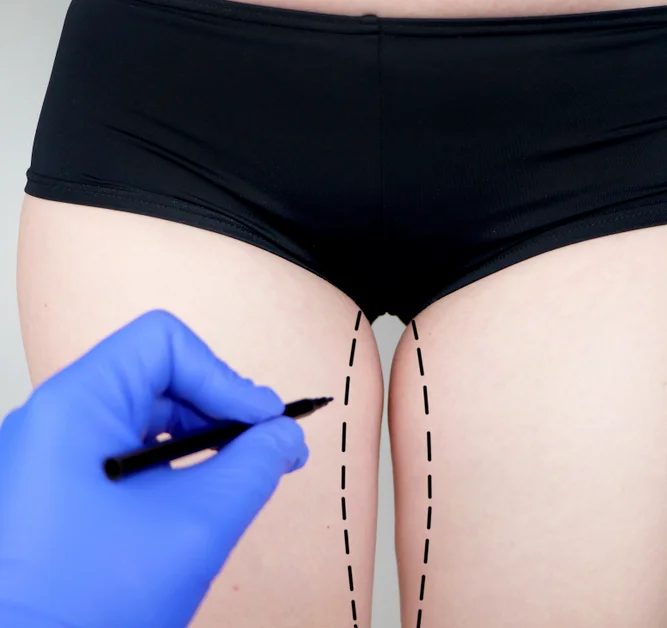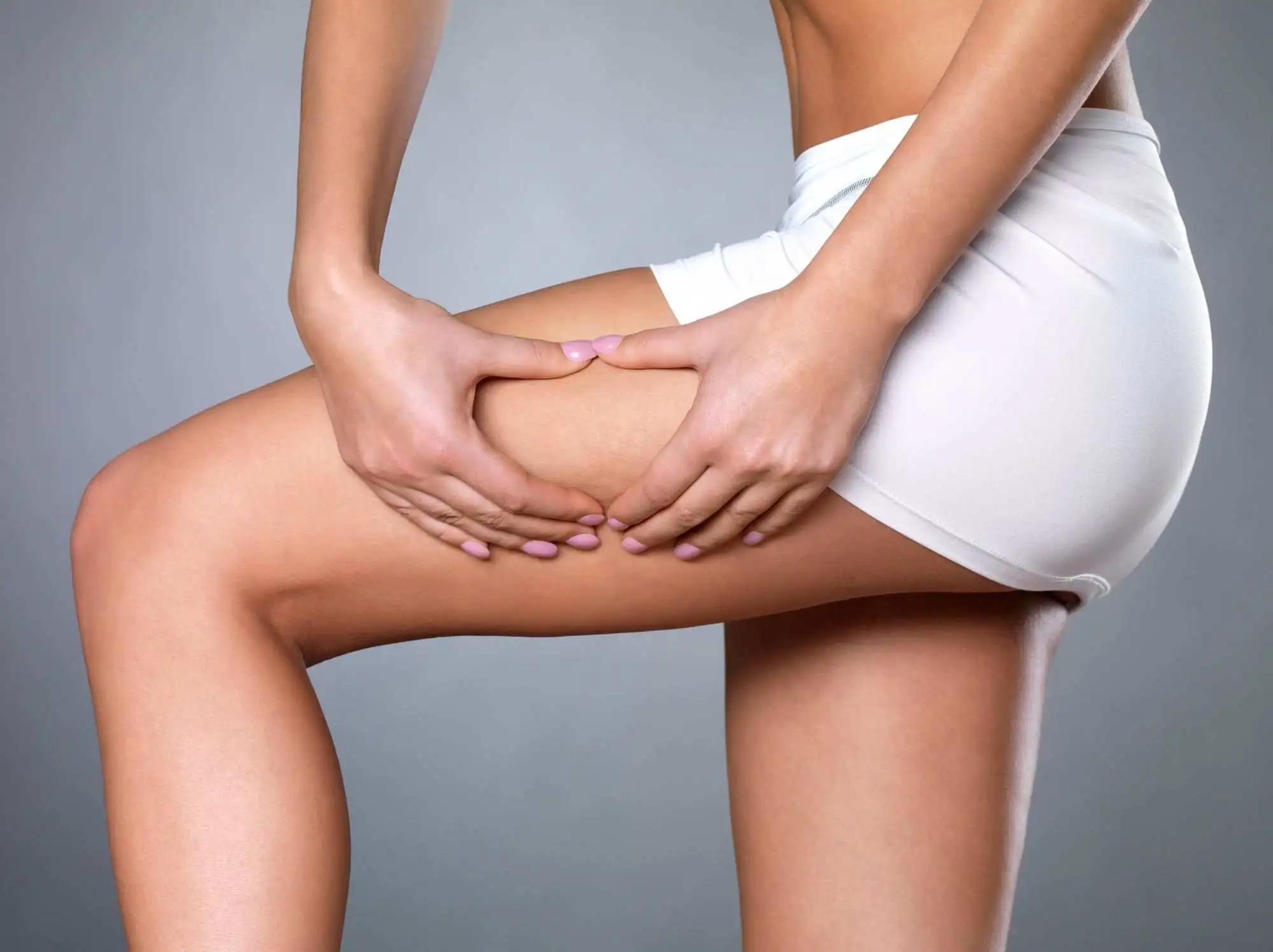Are you struggling to achieve the toned and smooth thighs you desire, despite diet and exercise efforts? Do you feel self-conscious about sagging skin in your thigh area? If so, you may want to consider a thigh lift procedure. Thigh lift surgery in riyadh can help to eliminate excess skin and fat, resulting in a firmer, more sculpted lower body. At Enfield Royal Clinic, our expert surgeons are dedicated to helping you achieve your ideal physique and boosting your confidence. Read on to learn more about the benefits of a thigh lift and how we can help you achieve the results you want.
Procedure Time
2 - 4 Hours
Downtime
2 Weeks
Back to Work
2 - 3 Weeks
Results
Immediate
What is Thigh Lift?
A thigh lift is a cosmetic surgery procedure that is aimed at improving the appearance of your thighs by removing excess skin and fat from the area. It is typically performed on people who have lost a significant amount of weight, or those who are unhappy with the sagging or drooping skin on their thighs due to aging or genetics.
Thigh lift can help to improve the appearance of your thighs and boost your confidence, it is important to remember that it is a surgical procedure and does carry some risks. These may include infection, bleeding, scarring, and changes in skin sensation.
If you are considering a thigh lift, it is important to speak with a qualified and experienced plastic surgeon to discuss your options and determine whether it is the right procedure for you. They can help you understand the potential risks and benefits, and work with you to develop a treatment plan that is tailored to your individual needs and goals.
Who needs a Thigh Lift?
A thigh lift is typically recommended for people who are unhappy with the appearance of their thighs due to excess skin and fat. This may be due to significant weight loss, aging, or genetics.
If you have lost a significant amount of weight and are left with sagging or loose skin on your thighs, a thigh lift may be a good option to improve the appearance of your legs. Similarly, if you are bothered by excess fat or skin on your thighs due to aging or genetics, a thigh lift may help you achieve a smoother and more toned look.
If you are considering a thigh lift, it is also important to have realistic expectations about the results. While a thigh lift can improve the appearance of your thighs, it is not a weight loss solution or a substitute for a healthy lifestyle.
Benefits of a Thigh Lift
The benefits of a thigh lift are:
- Improved appearance of the thighs.
- Removal of excess skin and fat.
- Creation of a smoother and more toned look.
- Increased comfort and ability to wear certain types of clothing.
- Enhanced mobility during physical activity.
- Long-lasting results with maintenance of a healthy weight and lifestyle.
- Potential improvement in mental health and self-esteem.
What’s the procedure like?

A thigh lift is a surgical procedure that is designed to improve the appearance of the thighs by removing excess skin and fat and creating a smoother, more toned look. Here is a general overview of the procedure:
Anesthesia
The first step of a thigh lift is administering anesthesia to ensure that you are comfortable and pain-free during the procedure. This may include general anesthesia, which will put you to sleep, or local anesthesia with sedation, which will numb the area but allow you to remain awake.
Incisions
Once you are under anesthesia, the surgeon will make incisions in the inner thigh area, typically along the natural crease of the groin. The length and location of the incisions will depend on the extent of the surgery and your individual needs.
Removal of Excess Skin and Fat
The surgeon will then remove the excess skin and fat from the thighs using various surgical techniques. This may involve liposuction to remove excess fat, as well as excision to remove excess skin.
Skin Tightening
After the excess skin and fat have been removed, the remaining skin will be pulled tight and sutured or stapled in place to create a smoother, more toned appearance.
Closing the Incisions
Once the skin has been tightened, the incisions will be closed with sutures or staples. The surgeon may also place drains in the incision sites to help remove any excess fluid or blood.
Recovery
After the procedure, you will need to follow your surgeon’s post-operative instructions carefully, including wearing compression garments, taking prescribed medication, and avoiding strenuous activities or exercise until you are fully healed.
Types of Thigh Lift
There are several different types of thigh lift procedures, each designed to address specific concerns and achieve specific goals. The most common types of thigh lift procedures include:
Inner Thigh Lift
This procedure focuses on the inner thighs, where excess skin and fat can cause chafing and discomfort. The surgeon will make incisions along your inner thigh and remove excess skin and fat before tightening the remaining skin.
Bilateral Thigh Lift
This procedure targets both the inner and outer thighs and involves making incisions along the groin and outer thigh. The surgeon will then remove excess skin and fat from your thigh and tighten the remaining skin for a smoother, more toned appearance.
Medial Thigh Lift
This procedure is similar to the inner thigh lift but involves a smaller incision and a more targeted approach. The surgeon will remove excess skin and fat from the upper inner thigh to create a more defined and toned appearance.
Mini Thigh Lift
This procedure is a less invasive option for those with mild to moderate excess skin and fat on the thighs. The surgeon will make a small incision in your groin and use liposuction to remove excess fat before tightening the skin.
Extended Thigh Lift
This procedure is recommended for those with significant excess skin and fat on the thighs, often as a result of massive weight loss.
What risks are involved?
The following risks are involved:
- Bleeding: Excessive bleeding can occur during or after the procedure.
- Infection: Infections can occur in the incision sites, which may require antibiotics or further medical attention.
- Poor Wound Healing: You may experience delayed or poor wound healing, which can result in scarring, infections, or other complications.
- Numbness:You may experience temporary or permanent numbness in the thigh area due to nerve damage during the procedure.
- Blood Clots: Blood clots can form in your legs after surgery, which can be potentially life-threatening if they travel to the lungs.
How to minimize the risks?
Here are some ways to reduce the risk of complications:
- Choose a Qualified Surgeon: One of the best ways to minimize risks is to choose a qualified and experienced plastic surgeon who has a good reputation and a record of successful surgeries.
- Follow Pre-Operative Instructions: Your surgeon will provide you with instructions to prepare for the surgery, such as avoiding certain medications or supplements, quitting smoking, and maintaining a healthy diet and exercise routine.
- Manage Pain and Swelling: Pain and swelling are common after a thigh lift, but you can minimize these symptoms by taking prescribed pain medication, using ice packs or compression garments, and staying well-hydrated.
- Avoid Smoking: Smoking can increase the risk of complications such as poor wound healing, so it is important to avoid smoking before and after the surgery.
Recovery time
The recovery time for a thigh lift varies, but generally, you can expect a recovery period of several weeks to a few months. During the first week after surgery, you will need to rest and avoid any strenuous activities or exercise. You might experience some pain, swelling, bruising, or discomfort, which can be managed with medication and proper wound care. By the second week, you will be able to return to light activities and work, although you should still avoid any strenuous exercise or heavy lifting. It can take several weeks to a few months to fully recover from a thigh lift, and you should follow your surgeon’s instructions carefully to ensure a safe and successful outcome.
After care
After a thigh lift surgery, proper aftercare is crucial for a safe and successful recovery. You should follow your surgeon’s instructions carefully, including any medication, wound care, or activity restrictions. During the initial recovery period, you should rest and avoid any strenuous activities or exercise to reduce swelling, promote healing, and minimize the risk of complications. Wearing compression garments can also help reduce swelling and promote healing. You should keep the surgical area clean and dry, and avoid soaking in baths or swimming pools until you have been cleared by your surgeon.
Cost of Thigh Lift
The cost of a thigh lift in Riyadh, Saudi Arabia can vary depending on several factors, such as the extent of the procedure, the surgeon’s experience, and the location and reputation of the clinic or hospital.
Generally The price of a thigh lift surgery in Riyadh can range from SAR 18,000 to SAR 23,000.
Thigh Lift
Starting FromThigh Lift
StandardWhy Choose Us?
If you are considering a thigh lift or any other cosmetic surgery in Riyadh Saudi Arabia, we invite you to book a consultation with us to learn more about our services and how we can help you achieve your desired results. Our team of experts is dedicated to providing you with the care and attention you deserve, and we look forward to helping you achieve your aesthetic goals.
FAQs.
Thigh lift surgery is usually performed under general anesthesia, which means that the patient is asleep during the procedure.
The length of a thigh lift surgery can vary depending on the extent of the procedure, but generally takes between 2-4 hours.
Patients typically require 1-2 weeks of recovery time before they can resume normal activities, and may need to wait 4-6 weeks before engaging in strenuous exercise or physical activity.
Yes, there will be scars after thigh lift surgery. However, the scars are typically placed in areas that can be easily concealed by clothing, and can fade over time with proper aftercare.
Relevant Treatments.

Butt Lift
A butt lift, also known as Belt lipectomy, is a procedure used to remove or reduce extra, sagging skin from the buttocks and thighs that has grown due to heredity, aging, gravity, or weight loss. The buttocks appear less sagging, dimpled, or wrinkled after a buttock lift because ...

Lower Body Lift
A lower body lift involves the trimming and tightening of your thighs, buttocks, and lower abdomen in addition to the removal of extra skin, fat, and tissue. Patients who had significant weight loss and have loose, sagging skin usually have this treatment done. The loose skin on the...
Relevant Posts.

Thigh Lift cost in Riyadh
Ever found yourself longing for sleeker, more contoured thighs, but wondered if there’s a solution that goes beyond exercise? Curious about the secrets behind achieving sculpted confidence? Well, have you ever considered a Thigh Lift? Learn more about Thigh Lift costs in Riyadh. It is a type of cosmetic surgery where extra skin and, sometimes, fat are removed to tighten and contour the thighs. People who have undergone major weight loss or ageing, which causes the skin in the thigh area to sag and lose its suppleness, frequently seek this operation.




